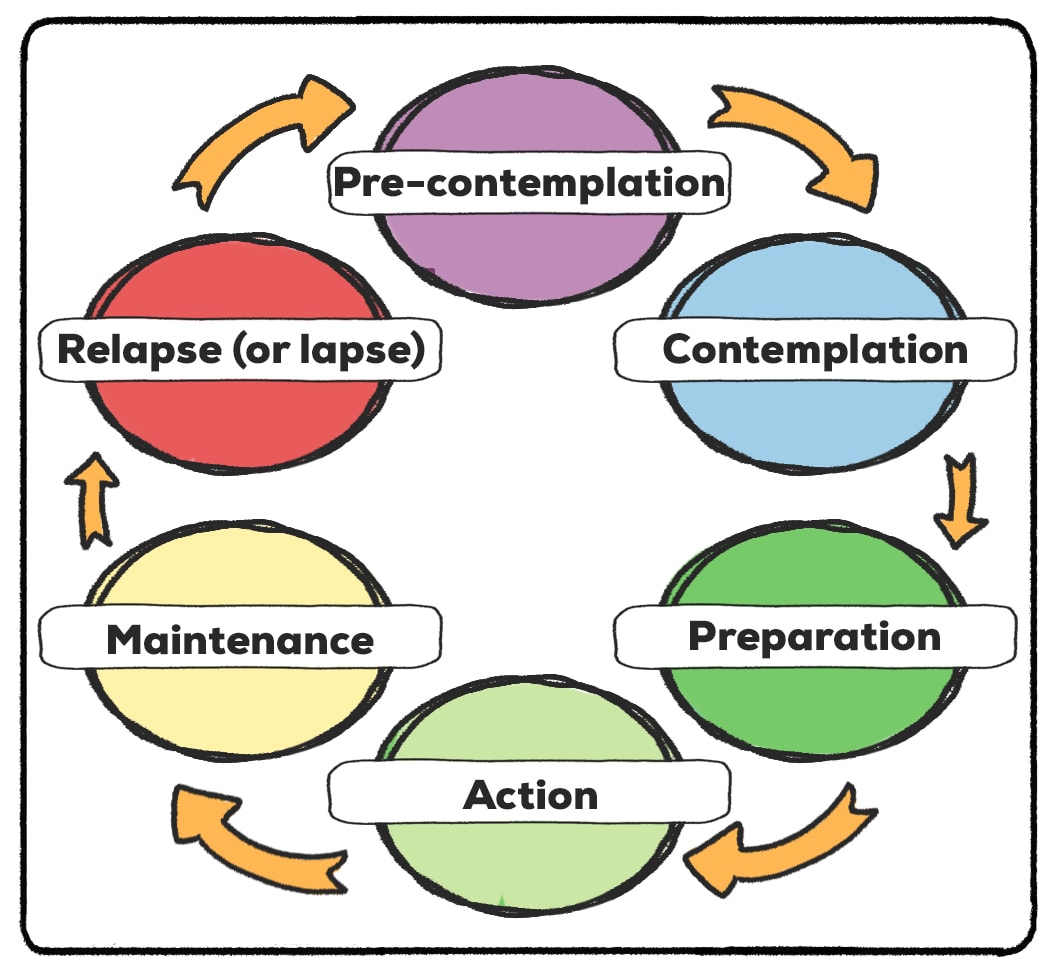The Transtheoretical Model of Change Is Used to Describe
Stages of Change Cycle of Change. Transtheoretical Model TTM of Change Prochaska et als 2007 transtheoretical model TTM is often used in conjunction with MI.
Transtheoretical Model Stages Of Behavior Change Note Adapted From Download Scientific Diagram
Use the Transtheoretical Model of Change to describe the process of change for the following 3 cases of health and wellness related behavioral modification.
. TTM conceptualizes behavior change as a process involving a series of six distinct stages. Apply the acquired information to complete your assignmentIdentify a health behaviorExplain how each of the stages of behavior change from the transtheoretical model of change can be applied to the health behaviorDescribe the types of strategies that could be used to move an individual from contemplation to actionExplain how these. The Transtheoretical model is a popular model used to describe behavior change and to support change through therapy.
LILACS PsycINFO PubMed Scopus and Pepsic. A systematic review of the transtheoretical model of behaviour change and alcohol use METHODS AND PROCEDURES Search strategies Five databases were searched. It outlines the five stages a person goes through when addressing a problem.
Use the Transtheoretical Model of Change to describe the process of change for the following 3 cases of health and wellness related behavioral modification. Identify each of the 6 stages of the TTM and discuss the corresponding behavior and mental state of the individual. Prochaska and Velicer 1997 is a dynamic theory of change based on the assumption that there is a common set of change processes that can be applied across a broad range of health behaviors.
Incorporates an understanding of the natural dynamic tendencies that individuals show regarding self-change. Insert the relapse in the appropriate phase and discuss where the. Identify each of the 6 stages of the TTM and discuss the corresponding behavior and mental state of the individual.
The Transtheoretical Model. Insert the relapse in the. BACKGROUND OF THE TRANSTHEORETICAL MODEL.
The transtheoretical model is a theory used to describe behavior modification. The model includes six stages of change as well as 10 different processes of change and is often associated with health related change. Transtheoretical Model of Change.
PE 205 Assignment 2 Directions. The TTM uses the stages of change model in which theorists of the TTM posit that people change through a sequential process progressing from. The transtheoretical model TTM describes change not as an individual event but rather as a series of steps that take place according to a persons degree of motivation.
The Transtheoretical Model of Behavior Change TTM created by Prochaska and DiClemente 1983 is one of the more popular theories used to describe this event. The following search descriptors were used. The Transtheoretical Model also called the Stages of Change Model developed by Prochaska and DiClemente in the late 1970s evolved through studies examining the experiences of smokers who quit on their own with those requiring further treatment to understand why some people were capable of quitting on their own.
The model was first published in the late 1970s by James Prochaska and Carlo DiClemente and has since been expanded upon and applied to a variety of. PE 205 Assignment 2 Directions. The transtheoretical model TTM Prochaska et al 1994 2002.
Whereas other models of behavior change focus on just one dimension of change for example they focus mainly on social factors or psychological. Identify each of the 6 stages of the TTM and discuss the corresponding behavior and mental state of the individual. The Transtheoretical Model TTM is an integrative biopsychosocial model used to conceptualize the process of intentional behavior change that is an individuals readiness to act on new healthier behavior.
Use the Transtheoretical Model of Change to describe the process of change for the following 3 cases of health and Boost Your Grades With Us Today. The most explored construct is the five stages of. The Transtheoretical Model TTM of behavior change is an integrative theory of psychotherapy that posits that individuals progress through a series of stages when modifying problematic behaviors.
The four constructs of TTM are the stages of change the processes of change self-efficacy and decisional balance. Initially describing only smoking cessation further studies have shaped the model to. The TTM has become one of the most widely accepted model of health behavior change.
The Transtheoretical Model TTM is an integrative health behavior change theory that describes the process of how people change their behavior. The central organizing construct in the theory is stages of change which are five distinct stages of readiness to change behavior ranging from not ready to change precontemplation thinking about change contemplation. 14 The model was developed inductively through study of the change strategies used by individuals who independently quit tobacco use.
Pre-contemplation involving the four R. What are the 5 stages of change. Use the Transtheoretical Model of Change to describe the process of change for the following 3 cases of health and wellness related behavioral modification.

Transtheoretical Model And Stages Of Change Examples Practical Pie

Transtheoretical Model An Overview Sciencedirect Topics
The Transtheoretical Model Of Behavior Change Download Scientific Diagram
No comments for "The Transtheoretical Model of Change Is Used to Describe"
Post a Comment